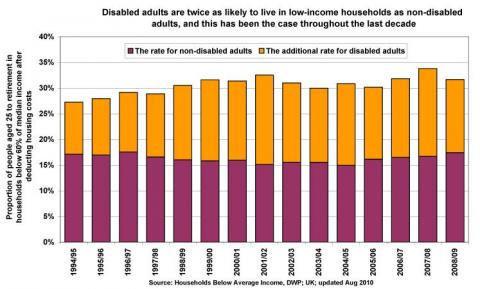Are one third of disabled people living in poverty?
"One in three disabled people is already in poverty; more will no doubt follow, with the cuts."
The Independent, 2 September 2012
The Paralympic Games have served not only as a worldwide spotlight for the achievements of disabled athletes, but has also brought to the surface debates about the condition of those disabled UK residents who do not wear the Team GB Uniform.
In particular, commentary is exacerbated by the Government's soon-to-be replacement of Disability Living Allowance (DLA) with Personal Independence Payment (PIP) which, some have argued, could prove to create a hurdle too high to clear.
One such article can be found in the Independent, published yesterday, claiming that although one third of people are currently in poverty, the onset of PIP could push even more below the poverty line.
But how many disabled people are in poverty?
Analysis
After contacting the author of the article, Full Fact was passed two main sources of the claim.
The first was a quote by the Chief Executive of Disability Rights UK in July 2012, who said that:
"A third of disabled people already live in poverty in the UK".
This is a figure previously used by the charity, and is sourced from Disability Alliance's 2009 manifesto "Tackling Disability Poverty". This figure in turn comes from a 2007 report by the Disability Rights Commission (DRC): "Ending Poverty and Widening Employment Opportunity".
However, the DRC closed in September 2007, and its responsibilty to secure and protect civil rights for disabled people was passed onto the Equality and Human Rights Commission (EHRC). The EHRC provided Full Fact with a copy of the old report, which did indeed use the figure as well::
"A reduction in the proportion of disabled people living in poverty by a quarter (from 30 per cent to below 23 per cent) by 2014."
Unfortunately, the report doesn't contain a source or citation for this figure.
The second source was more useful however. A section on disability and poverty from the Poverty Site, which was last updated in 2010, provides a graph showing the proportion of working age disabled people below the poverty line at over 30 percent in 2008/9:

The Households Below Average Income (HBAI) report (cited as the source) uses the results of The Family Resources Survey (FRS), an annual survey collecting information on the incomes and circumstances of about 25,000 private households to make estimates about the material living standards for the UK. The latest survey was published in June 2012, and contained results from 2010/11.
The HBAI analyses the material living standard of households by the amount of disposable income they have. A household is considered impoverished if it has a disposable income below 60% of the median income.
However, the HBAI defines "disposable income" in two ways and considers the income of three different age categories as well as the entire population. How you define "disposable income" and which age cateogry you look at leads to different results concerning the proportion of disabled households living below the poverty line.
Measuring poverty by age group
The proportion of those living in poverty can alter according to age group. The source of the Independent's claim, the Poverty Site, measures the income of individuals between 25 and retirement.
But the HBAI also provides data on three age categories, including for the whole populations: children (dependents up to 19), working age (ages 25 to retirement) and pensioners.
Each age category contains slightly different proportions of people below the poverty line.
For children living in a household with one disabled individual, 22 percent were below the poverty line before housing costs are accounted for (BHC) and 33 percent after housing costs (AHC).
There was also a higher proportion of working age people living in a disabled household below the poverty line, compared to the whole population. 22 percent were below if measured BHC, and 29 percent if measured AHC. This is a sharp
Pensioners, however, were the only category with proportions below the whole population. 17 percent of pensioners living in a household with at least one disabled person were classified "in poverty" BHC and 14 percent AHC.
Conclusion
The Independent's source measures the proportion of disabled working age people who are below the poverty line in income is measured after housing costs are accounted for.
However, this is not the only way of presenting the Households below average income data. The proportion of disabled people in poverty can depend on what age group you are looking at, or whether you are considering the whole population, and how you define "disposable income".
Different ways of presenting the data would therefore potentially reveal a smaller proportion of disabled people below the poverty line than the third claimed.